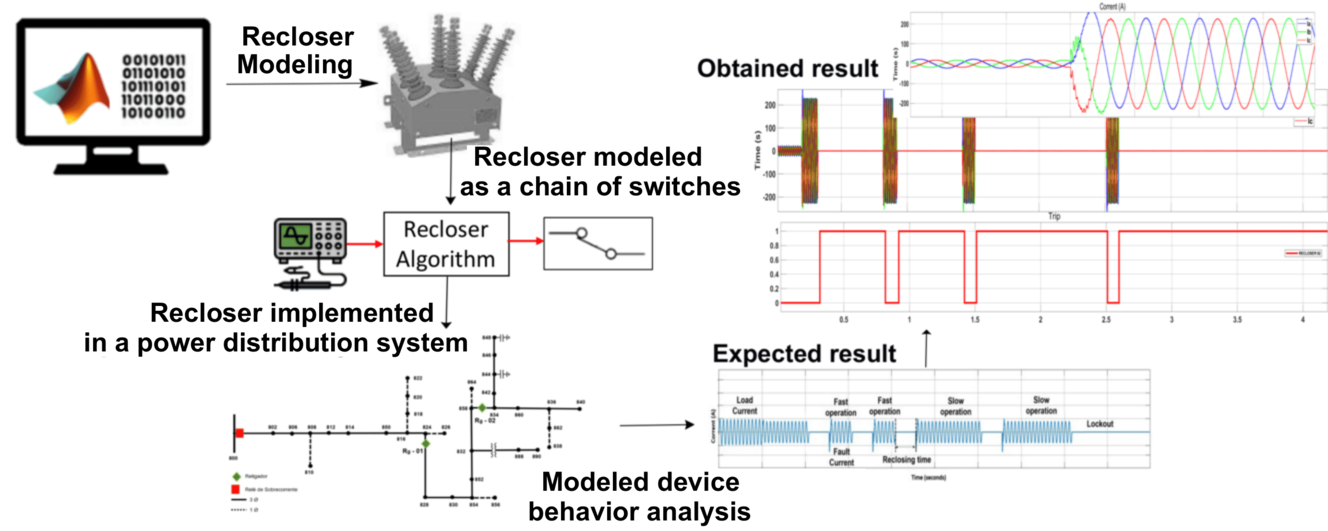Reclosers Modeling for Temporal Simulation of Distribution Networks in Simulink/ Matlab®
Modelado de reconectadores para simulación temporal de redes de distribución en Simulink/Matlab®
Keywords:
protection, digital recloser, electricity distribution systemsAbstract
Over the past few years, Brazil’s increasing dependence on electricity has caused a continuous growth in demand and, therefore, the need to guarantee long-term energy supply to custumers. Hence, studying the devices that are responsible ensuring this continuity is critical since the improper operation of this equipment can reduce the reliability of the electrical energy distribution system, therefore requiring detailed study that incorporates simulations, modeling, and analysis of response capacity in the face of real loads. Simulink/Matlab is one of the most widely used software programs in academia. However, it does not have readymade templates for protection system equipment such as relays, fuses, and reclosers. Herein, the aim is to model the digital recloser using the S-function block of Simulink/Matlab®. The proposed model for the recloser follows the configurations required by Brazilian electricity distribution companies, i.e. four operations divided into fast and slow, the latter one being responsible for permanently opening the section of the system on fault. To validate the modeled device, the IEEE 34-bar system was used, in which several operational cases were considered. The results obtained show that the proposed digital recloser model performed successfully proved to be a promising proposal for protection studies of power distribution systems.
Downloads
References
ANEEL, “Adaptive overcurrent protection system applied to electricity distribution systems,” Procedimentos de Distribuição de Energia Elétrica no Sistema Elétrico Nacional–PRODIST, pp. 1–76, 2010.
J. P. NASCIMENTO et al., “Adaptive overcurrent protection system applied to electricity distribution systems,” 2020.
C. Bonetti, J. Bianchotti, J. Vega, and G. Puccini, “Optimal segmentation of electrical distribution networks,” IEEE Latin America Transactions, vol. 19, no. 8, pp. 1375–1382, 2021.
S. Chan and R. Maurer, “Modeling overcurrent relay characteristics,” IEEE computer applications in power, vol. 5, no. 1, pp. 41–45, 1992.
J. Witte, S. Mendis, M. Bishop, and J. Kischefsky, “Computer-aided recloser applications for distribution systems,” IEEE computer applications in power, vol. 5, no. 3, pp. 27–32, 1992.
A. L. Da Silva, A. M. Cassula, L. C. Resende, R. M. Almeida, M. T. Yamasaki, and G. M. Paula, “Reliability evaluation of distribution systems considering automatic reclosers,” in 2004 International Conference on Probabilistic Methods Applied to Power Systems, pp. 100–105, IEEE, 2004.
G. A. G. Mercado and J. W. G. Sanchez, “Optimization of reclosers placement in distribution networks to improve service quality indices,” IEEE Latin America Transactions, vol. 20, no. 2, pp. 241–249, 2021.
N. d. O. P. Westin et al., “Optimal recloser placement in a distribution network considering short-term voltage variations,” 2020.
A. A. Téllez, L. Ortiz, M. Ruiz, K. Narayanan, and S. Varela, “Optimal location of reclosers in electrical distribution systems considering multicriteria decision through the generation of scenarios using the montecarlo method.,” IEEE Access, 2023.
A. E. C. Momesso, G. Y. Kume, W. R. Faria, B. R. Pereira, and E. N. Asada, “Automatic recloser adjustment for power distribution systems,” IEEE Transactions on Power Delivery, vol. 37, no. 5, pp. 3958–3967, 2022.
J. A. Yousaf, Muhammad, K. M. Muttaqi, and D. Sutanto, “An adaptive overcurrent protection scheme for dual-setting directional recloser and fuse coordination in unbalanced distribution networks with distributed generation,” IEEE Transactions on Industry Applications, vol. 58, no. 2, pp. 1831–1842, 2022.
E. E. Pompodakis, Y. A. Katsigiannis, and E. S. Karapidakis, “Optimizing fault ride-through of dgs in distribution networks to preserve recloser-fuse coordination,” IEEE Access, vol. 12, pp. 31228–31242, 2024.
C. B. Tischer and R. F. d Camargo, “Analysis of synchronization methods applied to parallel active power filters using simulink/matlab software,” Salão do Conhecimento, 2009.
D. R. Mamede Filho, J. Mamede, Proteção de Sistemas Elétricos de Potência, vol. 2 ed. LTC Livros Técnicos e Científicos LTDA, 2020.
M. Oleskovicz, “Qualidade da energia elétrica,” Edição do autor, São Carlos, 2007.
A. A. Bittencourt et al., “Adaptive protection for distribution feeders considering distributed generation,” 2011.
ENERGISA, “Automatic single-phase circuit relcoser,” p. 34, 2021.
L. Comassetto et al., Heuristic algorithms for protection optimization and in power distribution networks. PhD thesis, Universidade Federal de Santa Maria, 2008.
I. Standard, “Publication no. 255-4,” 1976.
I. Standard, “Publication no. 255-4,” Single Input Energizing Quantity Measuring Relays With Dependent Specified Time, 1976.
L. F. d. F. Gutierres et al., “Proposal for a protection system to preserve coordination between reclosers and fusible links in distribution systems in the presence of distributed generation,” 2013.
A. E. C. Momesso, Uma proposta de proteção adaptativa com religadores em sistemas de distribuição de energia elétrica. PhD thesis, Universidade de São Paulo, 2022.
J. P. Nascimento, N. S. D. Brito, and B. A. de Souza, “Proposition of an adaptive protection scheme for distribution systems with distributed generation,” IEEE Latin America Transactions, vol. 16, no. 5, pp. 1439–1444, 2018.
W. H. Kersting, “Radial distribution test feeders,” IEEE Transactions on Power Systems, vol. 6, no. 3, pp. 975–985, 1991.
D. T. FEEDERS, “Ieee pes distribution system analysis subcommittee,” 2020.
F. Sato and W. Freitas, “Short-circuit analysis and protection principles in power systems,” Rio de Janeiro: Elsevier, 2015.


